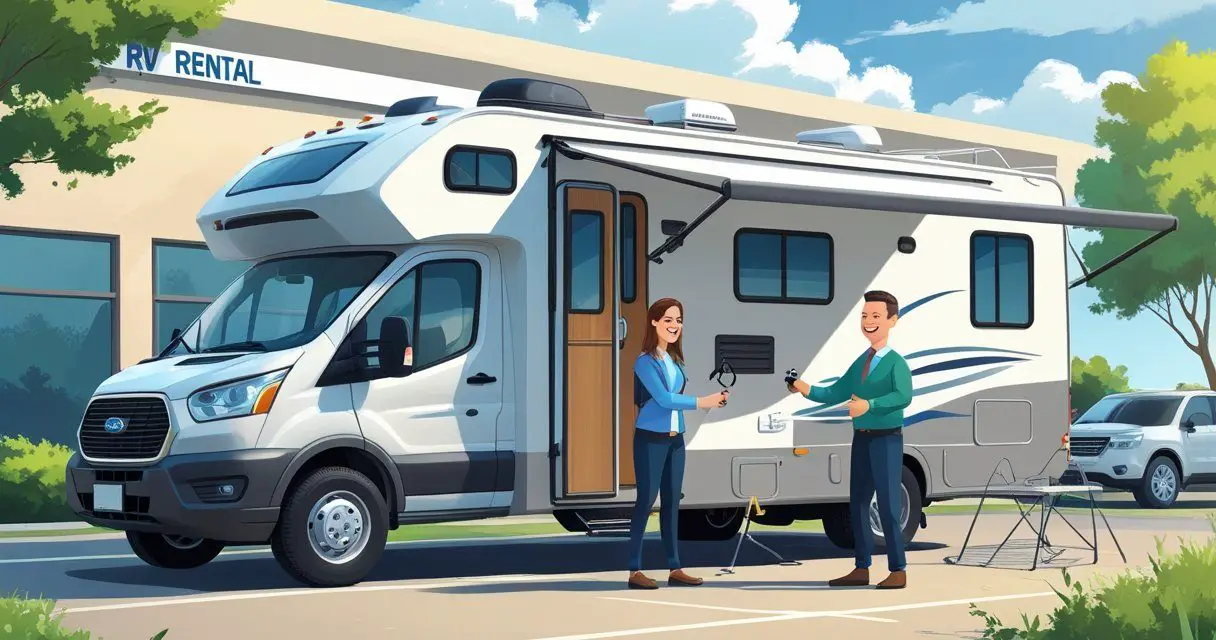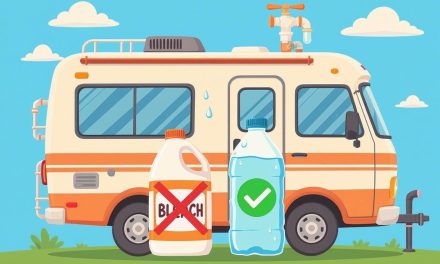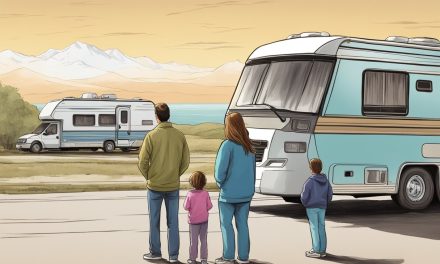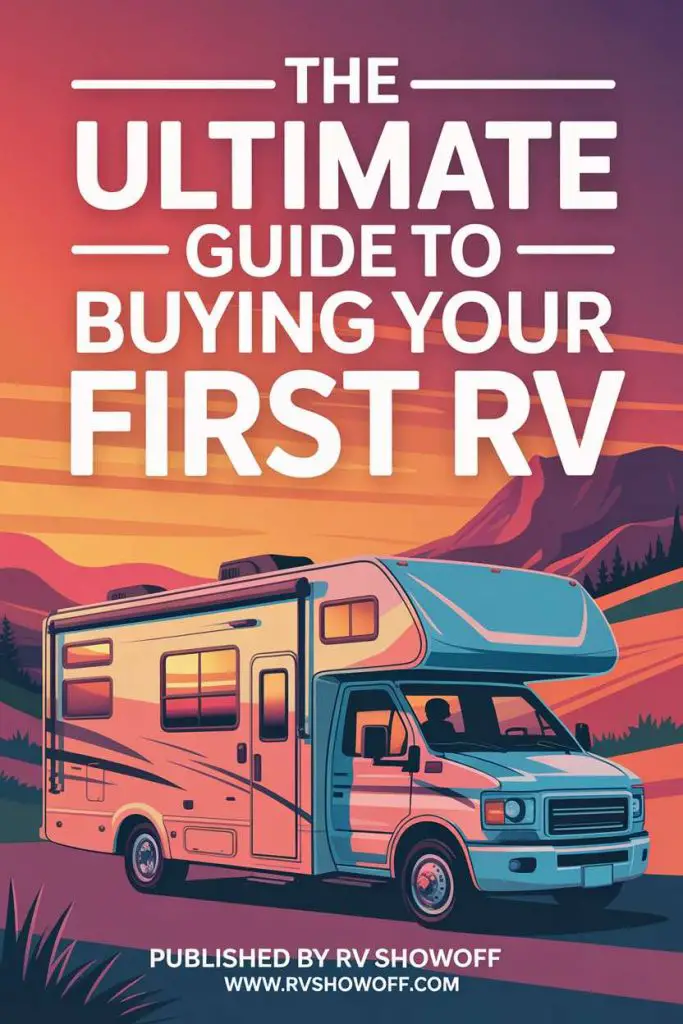Would you like to save this article?
Yes, you can rent an RV, and the process is more flexible than many expect. You can choose from drivable motorhomes or towable trailers, and rentals are available through both large companies and peer-to-peer platforms.
This makes it possible to find an option that fits your budget, comfort level, and travel plans.
Renting an RV gives you the chance to explore without committing to ownership. You can test different types of vehicles, from compact campervans to large motorhomes, and decide what works best for your trip.
Some rental options even include delivery and setup, so you can skip the hassle of driving or parking.
Costs, rental rules, and included amenities vary, but with the right planning, you can enjoy a smooth experience. Knowing where to rent, what type of RV to choose, and what fees to expect will help you avoid surprises and focus on the trip itself.
Key Takeaways
- You can rent different types of RVs to match your travel needs
- Rental costs and rules vary by company and vehicle
- Planning ahead makes the RV rental experience easier and more enjoyable
Can RV Be Rented: Overview of the Process
You can rent an RV through large rental companies or peer-to-peer platforms. The process usually includes choosing a vehicle type, understanding costs, and meeting basic requirements.
The details vary depending on the company, the owner, and the type of RV you select.
How RV Rentals Work
When you rent an RV, you first choose between drivable motorhomes (Class A, B, or C) and towable trailers (such as fifth wheels or pop-ups). Drivable RVs are easier if you don’t own a tow vehicle, while towables can be more affordable if you already have a capable truck or SUV.
You can book through rental companies like Cruise America, which offer standardized vehicles, or through peer-to-peer platforms like RVshare and Outdoorsy, where individual owners list their RVs.
Company rentals are consistent, while peer-to-peer rentals provide more variety in size, style, and amenities.
Most rentals include insurance options and roadside assistance, but you may need to pay extra for mileage, cleaning, or equipment like linens and cookware. Some owners also offer delivery to your home or campground, which can save you from having to drive or tow the RV yourself.
Who Can Rent an RV
In most cases, you need to be at least 25 years old to rent an RV. Some companies allow renters as young as 21, but you may face higher insurance costs.
A valid driver’s license is required, and for most RVs under 26,000 pounds, you do not need a special license.
Rental companies often run a driver background check to confirm eligibility. If you plan to tow a trailer, you must also verify that your vehicle has the proper towing capacity and hitch setup.
You should also be prepared to provide a security deposit, which is refunded if the RV is returned without damage. Rules about pets, smoking, and festivals vary by owner and must be checked before booking.
Types of Rental Options
RV rentals are flexible, and you can choose from several formats depending on your needs:
- Round-trip rentals: Pick up and return to the same location.
- One-way rentals: Start in one city and drop off in another, sometimes at a discount.
- Stationary rentals: Stay in an RV parked at a fixed site without driving.
- Delivery rentals: Have the RV delivered and set up at your destination.
Large companies usually focus on round-trip or one-way rentals, while peer-to-peer platforms often include delivery and stationary options. This flexibility lets you decide whether you want to drive, tow, or simply stay in an RV without moving it.
Types of RVs Available for Rent
When you rent an RV, you can choose between large drivable motorhomes, compact camper vans, mid-size Class C units, or towable RVs like travel trailers. Each type offers different sizes, layouts, and costs, so the right choice depends on your group size, driving comfort, and budget.
Class A Motorhomes
Class A motorhomes are the largest drivable RVs. They are built on commercial bus or heavy-duty truck frames and usually range from 26 to 45 feet long.
You’ll find spacious interiors with full kitchens, large bathrooms, and multiple sleeping areas. These RVs often include extras like slide-outs, washer/dryer hookups, and king beds.
Some models use gas engines, while diesel pushers have more power and durability.
Key details:
- Sleeps: 4–8 people
- Average rental price: about $300 per night
- Best for: long trips, large families, or travelers who want maximum comfort
While you get luxury and space, Class A RVs can be harder to drive, have low fuel efficiency, and may not fit in smaller campgrounds.
Camper Vans and Class B RVs
Class B RVs, often called camper vans, are the smallest drivable motorhomes. They look like oversized vans and measure about 18 to 24 feet long.
Despite their compact size, they usually include a bed, small kitchen, and sometimes a wet bath. You can drive them almost anywhere, including national parks and city streets, making them a flexible choice.
Some models have pop-up roofs for standing space, while others are built on Sprinter, Transit, or Promaster chassis.
Key details:
- Sleeps: 2–4 people
- Average rental price: about $230 per night
- Best for: couples, solo travelers, or those who want easy driving
Fuel economy is better than larger RVs, but storage and living space are limited.
Class C Motorhomes
Class C motorhomes are mid-size RVs that balance space and drivability. They are built on a truck or van chassis and are easy to recognize by the cab-over bunk above the driver’s area.
Sizes range from 24 to 40 feet, giving you more room than a camper van but less bulk than a Class A. Inside, you’ll find a full bathroom, kitchen, and multiple sleeping areas.
Many models also include slide-outs for added space.
Key details:
- Sleeps: 4–8 people
- Average rental price: about $215 per night
- Best for: families who want comfort without the size of a bus-style RV
Class C RVs are easier to handle than Class A units, but still offer generous living space.
Towable RVs and Travel Trailers
Towable RVs include travel trailers, fifth wheels, pop-up campers, and toy haulers. These attach to a tow vehicle instead of being driven on their own.
Travel trailers are the most common, ranging from 10 to 40 feet long with flexible floor plans. Fifth wheels are larger and connect with a hitch in the truck bed, offering more stability.
Pop-up campers are lightweight and fold down for towing, while toy haulers include a garage for ATVs or bikes.
Key details:
- Sleeps: 2–10 people depending on size
- Average rental price: $90–$170 per night
- Best for: travelers with a capable tow vehicle who want flexible options
Towable RVs usually cost less to rent than motorhomes, but you must factor in the vehicle needed to tow them.
Where to Rent an RV
You can rent an RV through large rental companies with standardized fleets or from individual owners using peer-to-peer platforms. Each option has different costs, rules, and levels of flexibility.
Peer-to-Peer RV Rental Platforms
Peer-to-peer platforms like RVshare and Outdoorsy connect you directly with RV owners. This setup is similar to Airbnb, where you browse listings, compare features, and book the one that fits your needs.
These platforms give you access to a wide range of vehicles, from small campervans to large motorhomes. You can filter by location, price, amenities, and whether pets are allowed.
Some owners even offer delivery to your home or campsite, which can save you from driving a large vehicle. Insurance is usually built into the booking.
For example, RVshare includes coverage and roadside assistance in its rentals. Outdoorsy also provides insurance but terms can vary by listing.
Pros:
- Large selection of RV types and sizes
- Flexible rental options like one-way trips or stationary rentals
- Ability to work directly with owners
Cons:
- Rules, fees, and quality vary by owner
- Extra charges may apply for cleaning or mileage
Traditional RV Rental Companies
Companies like Cruise America and El Monte RV operate more like car rental agencies. You pick up a vehicle from one of their nationwide locations, and each RV of the same model is nearly identical.
This consistency makes the process simple if you’re new to RVing. You know what you’re getting, and staff walk you through the basics before you leave.
Cruise America, for example, offers four standard motorhome sizes plus a truck camper.
However, costs can add up. You often pay per mile driven, plus extra for kitchen kits, linens, and insurance.
These rentals may be better suited for short trips where you plan to stay parked for several days.
Pros:
- Standardized vehicles with predictable layouts
- Multiple pickup locations across the country
- Professional support and customer service
Cons:
- Extra fees for mileage and supplies
- Limited variety compared to peer-to-peer rentals
Comparing RV Rental Providers
When choosing between platforms and companies, think about what matters most to you: variety, cost, or convenience.
| Option | Best For | Key Features | Possible Drawbacks |
|---|---|---|---|
| RVshare / Outdoorsy | Flexibility & unique RVs | Wide selection, delivery options, direct owner contact | Inconsistent rules, cleaning fees |
| Cruise America / El Monte RV | Simplicity & reliability | Standardized fleet, nationwide locations, staff support | Mileage charges, fewer RV styles |
If you want a unique RV near a specific location, peer-to-peer sites usually have more options. If you want a predictable experience with fewer surprises, traditional companies may be the safer choice.
RV Rental Costs and Fees
When you rent an RV, you pay more than just the nightly rate. Costs depend on the type of RV, how far you travel, and what extra services or equipment you use.
Careful budgeting helps you avoid surprises.
Factors That Affect Rental Prices
The type of RV you choose makes a big difference in price. Class A motorhomes often cost $150–$300 per night, while Class B campervans usually range from $100–$200.
Class C motorhomes fall between $125–$250, and towable trailers can be as low as $50–$150 per night.
Season and location also affect your costs. Summer and holidays bring higher rates, while off-season trips are cheaper.
Rentals in popular destinations often cost more than those in less-visited areas. Rental duration matters too.
Many companies offer discounts for weekly or monthly bookings. If you plan a longer trip, ask about reduced rates.
Mileage Fees and Generator Use
Most RV rentals include a set number of free miles per day. After that, you usually pay per mile.
A common rate is $0.35 per extra mile, but this varies by company. If you plan to travel long distances, these charges can add up quickly.
Generators also come with limits. Rentals often include a few free hours of generator use per day.
After the limit, you may pay $3–$5 per hour. This is important if you plan to camp without hookups for power.
Tracking your mileage and generator time helps you avoid unexpected charges. Always confirm the exact limits before booking.
Additional Charges and Deposits
Beyond the base rental and mileage, you may face other fees. Insurance is often required, either through the rental company or your own provider.
Expect daily insurance costs around $20–$30. Most companies require a security deposit, which is refunded if the RV is returned in good condition.
Deposits can range from $500 to over $1,000 depending on the RV type. Other possible charges include cleaning fees, dumping fees if tanks are not emptied, and pet fees if you bring animals.
Fuel and campground fees are also your responsibility, so include them in your budget.
Planning Your RV Trip
Good planning helps you avoid problems on the road and makes your RV travel smoother. You need to think about where you want to go, where you will stay, and whether you want to try camping without hookups.
Choosing Destinations and Routes
Start by deciding what kind of RV trip you want. National parks, coastal drives, and scenic highways are popular choices.
Think about how far you want to drive each day and the type of activities you enjoy. Use RV-friendly apps or maps to plan your route.
These tools help you avoid low bridges, narrow roads, or weight restrictions that can be difficult for larger vehicles. They also estimate fuel costs and show rest stops along the way.
When planning, keep travel times realistic. RVs move slower than cars, and you will need more time for parking, fueling, and setting up at campgrounds.
A good rule is to limit driving to 4–6 hours per day.
Booking RV Parks and Campgrounds
RV parks and campgrounds vary in cost, size, and amenities. Some offer full hookups for water, electricity, and sewage, while others may only provide basic services.
Decide which features matter most to you, such as Wi-Fi, showers, or laundry facilities. Make reservations early, especially during peak vacation months.
Popular RV campgrounds near national parks or beaches often fill up months in advance. Booking ahead ensures you have a place to stay and reduces stress on your trip.
Check campground rules before booking. Some limit RV size, restrict pets, or have quiet hours.
Always confirm whether your RV will fit the site and whether you need a pull-through or back-in space.
Boondocking and Off-Grid Camping
Boondocking means camping without hookups, often on public lands. It gives you more freedom and can save money, but it requires extra preparation.
You need to manage water, power, and waste carefully. Bring leveling blocks, extra drinking water, and a generator or solar panels for electricity.
Limit power use by running only essential appliances. Plan meals that need fewer dishes to reduce water waste.
Check local regulations before parking overnight. Many national forests and Bureau of Land Management (BLM) areas allow free stays, but time limits usually apply.
Always follow Leave No Trace practices to keep the land clean for future campers.
Essential Tips for First-Time RV Renters
When you rent an RV for the first time, you need to prepare for both the vehicle and the trip itself. Paying attention to the details of setup, driving, and safety will help you avoid common mistakes and keep your trip running smoothly.
Preparing for Your Rental
Start by choosing the right RV size for your group. Class A motorhomes are large and spacious but harder to drive.
Class B campervans are compact and easier to handle, while Class C campers balance space and drivability. Check what’s included in the rental.
Many RVs come with basic kitchenware, linens, and sometimes outdoor gear. If you need specific items like a grill or chairs, confirm with the owner before pickup.
Review the insurance package provided by the rental company. Most rentals include standard coverage, but you may want to upgrade for extra protection.
Also, ask about mileage limits and fees for going over. Finally, make a packing checklist.
Essentials often include bedding, food, toiletries, and small tools. Don’t forget items like a flashlight, water hose, and leveling blocks, which can make setup much easier.
Driving and Parking an RV
Driving an RV feels different from driving a car. You’ll need more time to brake, wider turns, and extra space for lane changes.
Practice in an empty parking lot before heading out on the highway. You usually don’t need a special license unless the RV is over 26,000 pounds or longer than 40 feet.
Still, you should feel comfortable handling a larger vehicle before committing to a long trip. Plan your route with RV-friendly navigation.
Some apps show road grades, low bridges, and narrow roads that can cause problems. Avoid busy city streets and tight parking areas when possible.
When parking, look for level ground. If you’re at a campground, use leveling blocks if the site isn’t flat.
Always check overhead clearance before pulling into gas stations, drive-thrus, or tree-covered spots.
Managing Utilities and Safety
Hookups at campgrounds usually include water, electricity, and sewer. To connect safely, use a surge protector for power and a water pressure regulator for the hose.
Make sure the sewer hose is secured tightly to avoid leaks. Keep track of your propane tank.
It powers appliances like the stove, oven, and sometimes the fridge or heater. Always check for leaks by smelling for gas or using soapy water on connections.
Know how to manage wastewater. If your site doesn’t have sewer hookups, you’ll need to empty the gray and black tanks at a dump station.
Wear gloves and rinse the hose after use. Store a fire extinguisher in an easy-to-reach place.
Test smoke and carbon monoxide detectors before you leave. These small steps can prevent serious safety problems during your trip.
Roadside Assistance and Support
Mechanical issues can happen, especially on longer trips. Many rental companies offer 24/7 roadside assistance that covers flat tires, dead batteries, and towing.
Confirm this service is included before you travel. Keep the owner’s contact information handy.
If you can’t figure out how to use a system, such as the slideouts or generator, the owner can often walk you through it over the phone. If you run into fuel or tire problems, roadside assistance can send help directly to your location.
This support is especially valuable for first-time RVers. Carry basic tools and spare fuses.
Even with assistance, small fixes like a blown fuse or loose connection are easier to manage if you have the right supplies on hand.






